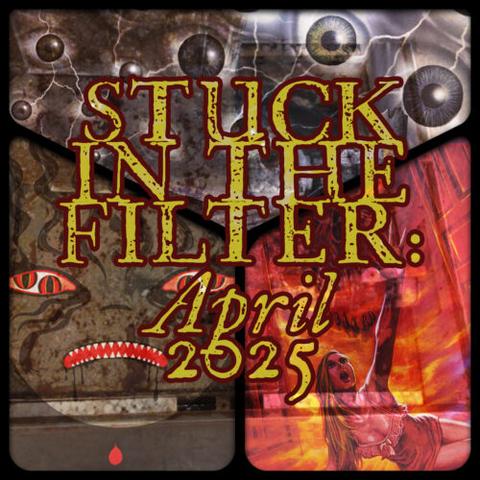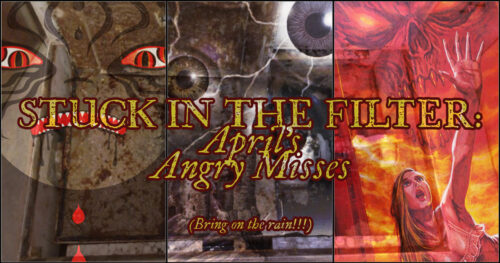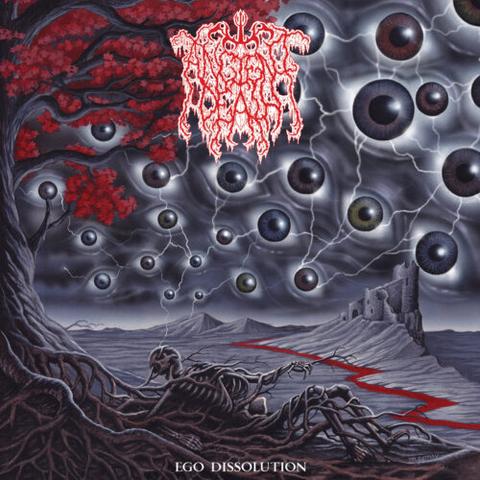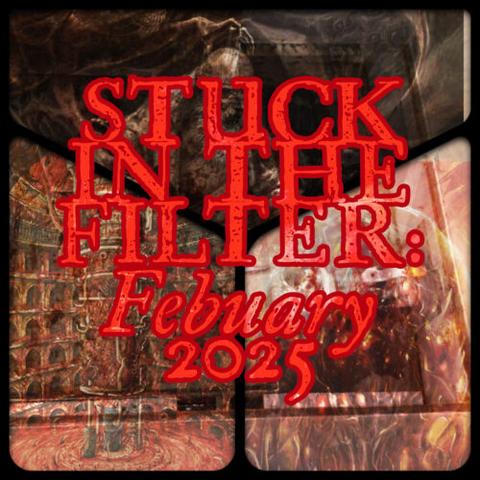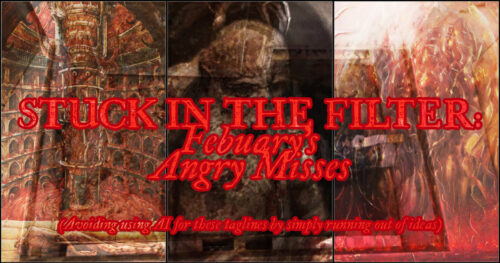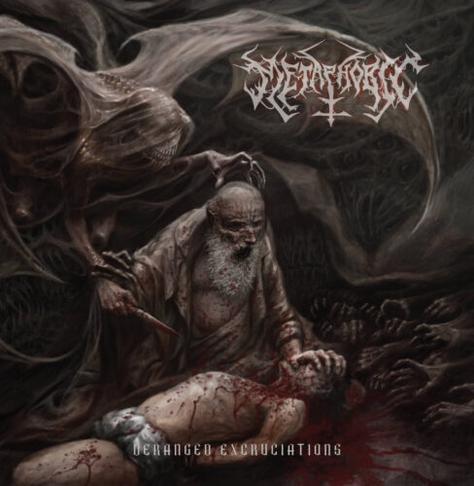Stuck in the Filter: April 2025’s Angry Misses
By Kenstrosity
The cicadas have passed, the brood has bred. And now, it’s all being washed away by a constant deluge of heavy rain and hail amidst thunderous storm of increasing intensity. I imagine those skyborne rumblings shudder every wall of the ducts where my minions toil. I am sure they are frightened, claustrophobic, and soaked. And yet, they persist under my demanding and ruthless management—all so you can have more of what you already get every day in these halls.
Show your appreciation for what we bring to you, and enjoy ov deep Filter!
Kenstrosity’s Biblically-Accurate Beast
Ancient Death // Ego Dissolution [April 18th, 2025 – Profound Lore Records]
A lot of people pine for Death. We know this due to the sheer number of Death worship acts out there, most of which operate eternally under that legend’s shadow. Less common, however, are acts of worship in the service of underground-er heroes The Chasm. Thankfully, Massachusetts death metal quartet Ancient Death take on this mantle, blending much Death and The Chasm inspo with their own curated, abyssal sound. Everything here hearkens back to the ways of olde, but updated to feel relevant in the modern era. Such as this is the case, opening salvos “Ego Dissolution” and “Breaking the Barriers of Hope” strike while the iron is hot, piercing through all expectation with sharp riffs, evolving passages, and dynamic shifts in structure. So effective is this attack strategy that even instrumental aberrations like “Journey to the Inner Soul” feel story driven and purposeful. Standout tracks like “Breathe – Transcend (Into the Glowing Streams of Forever),” “Echoing Chambers Within the Dismal Mind,” and “Unspoken Earth” steal the show, however, boasting Ancient Death’s best riffs, a downright surprising display of vocal versatility, and disgusting solos and dive bombs. It needs time and dedicated spins to bloom and come alive, though, which may discourage listeners hoping for a cheap fix. But trust me, it’s worth the investment!
Killjoy’s Flavorful Feasts
Malphas // Extinct [April 11th, 2025 – Soulseller Records]
If I’m to enjoy no-frills black metal, it needs to have lots of hooks. In this sense, Switzerland’s Malphas had their priorities straight while writing Extinct. Their melodic guitar leads may not be as exuberant or exaggerated as, say, Moonlight Sorcery’s, but they have a thrashy flair which is just as much fun. Once the riffs captured my attention, they reeled me in for a battering vocal assault of coarse barks and spiteful snarls. Drummer Jöschu Käser (also of Aara and many others) can play seemingly any rhythm or tempo, best exemplified across the entirety of “Butcher’s Broom.” This is key for Malphas to prove they have the nuance to pull off mid-paced tempos (“Majestic Moon,” “Consumed,” “Armada Christi”), a quality that I find important in black metal. There are a few neat little surprises as well, like the piano section midway through “Majestic Moon” and the icy synths popping up momentarily in the instrumental closer “Astral Dissonance.” Fans of engaging and catchy meloblack won’t want to miss out on Extinct.
Svnth // Pink Noise Youth [April 18th, 2025 – These Hands Melt]
You’ve likely heard of white noise, but what about its counterpart, pink noise? Whereas white noise contains equal amounts of all frequencies audible to humans, pink noise favors lower frequencies and is generally considered to be easier on the ears. Likewise, Pink Noise Youth, Svnth’s fourth album, is a remarkably pleasant listen. This unassuming post-black group from Rome, Italy has evolved considerably since Cherd’s review of 2020’s Spring in Blue. The familiar glossy guitar tremolos and chords now have an unexpected companion: the electric sitar. This newcomer is mainly supportive, with stray notes and lines drizzled atop the already dreamy guitars for extra sweetness. There are spicier moments, too, like the punky riffs and d-beats peppered with rasping barks that kick off “Winter Blues.” There’s also a much greater prevalence of clean singing this time around, Rodolfo Ciuffo’s hypnotic intonation complements the chunky post-metal of “Perfume” as easily as the carefree guitar strumming in “Nairoby Lullaby.” Gone are the overlong, meandering tracks of before; Pink Noise Youth gets straight to the point with sharper songs hovering in the 5-minute range across a tight 37 minutes in total. Svnth seem determined to make the post-black genre their own and, by all indications, it’s working.
Owlswald’s Wide-Eyed Wonders
Game Over // Face the End [April 25th, 2025 – Scarlet Records]
In the absolutely loaded month that was April, two records surprised these owl ears enough to earn regular spots in my playlist. First up is Game Over’s sixth full-length, Face the End. These Italian thrashers have been peddling their version of the Bay Area sound since 2009, yet this is somehow my first encounter with them. Following the departure of co-founder/bassist/vocalist Renato Chiccoli, Game Over revamped its lineup, bringing in Danny Schiavina on vocals and Leonard Molinari on bass. This refreshed five-piece delivers a newly polished sound, making Face the End the most fun I’ve had with a thrash album in recent memory. “Grip of Time,” “Weaving Fate” and “Veil of Insanity” showcase Game Over’s mastery of Testament and Exodus-level aggression while “Neck Breaking Dance” offers a light-hearted pit call reminiscent of early Anthrax. Alessandro Sansone’s and Luca Zironi’s fast and forceful down-picking, melodic leads and flashy solos run over Anthony Dantone’s rock-solid drumming, all within a crisp and powerful production with ample punch. Schiavina’s charismatic, high-flying vocals immediately grab your attention on “Lust for Blood,” never relinquishing their grasp as they transmit their 70s and 80s horror-inspired themes above abundant gang vocals. In a genre plagued by inconsistency, Face the End is everything I want my thrash to be—aggressive, dynamic and fun.
Kiritsis // Kiritsis [April 4th, 2025 – Wise Blood Records/Pout Records]
Next up is the ruthless sludge and hardcore of Kiritsis. I hope you checked your fun at the door because this Indianapolis-based quartet isn’t here to make friends. Formed by members of Trenches, Hatesong, and Sundown, Kiritsis’ self-titled debut is here to punch you square in the face and take your lunch money. Over the course of thirty-one minutes, this foursome bludgeons listeners with uncompromisingly heavy doses of abrasive distortion, hard-hitting beats and pure unadulterated anger, all slathered in a blackened layer of Carcass-like filth. Blake Henry’s roars and rasps tear through your speakers with pure vitriol and torment, perfectly complementing Eric Mason’s grim riffing, Bill Scott’s demonic bass growls and Nik Jensen’s weighty drum strikes. “Like the Taste,” “Pissant” and “Deny.Defend.Dispose” embody a Will Haven spirit with a barrage of penetrating, assaulting riffs and pounding half-time slams underpinning Henry’s blood-curdling screams. Meanwhile, the sorrowful and doom-tinged “It Ain’t Easy” and “Thieves and Fools” drag you into anguish-ridden depths, draped in their dark, hopeless atmospheres and plodding facades. You won’t find any overly technical or flashy music here—this is pure hatred and loathing in a tight, cathartic package, meant to blast at high volume while you fuck shit up.
Tyme’s Grungy Gift
Melvins 1983 // Thunderball [April 18th, 2025 – Ipecac Recordings]
Hot on the heels and building off of 2024’s Tarantula Heart, stalwart grunge/sludge rock icon Buzz Osborne has teamed back up with original drummer Mike Dillard for Melvins 1983‘s third release and first in four years, Thunderball. This time around, Osborne and Dillard have partnered with experimental electronic artists Void Manes and Ni Maîtres to deliver yet another in a long line of inimitable, don’t-give-a-fuck-what-you-think releases that have become synonymous with the Melvins brand. As influential a band as any going right now on sludgy noise rock emanating from garages across the world, I take note anytime a new Melvins project hits shelves. With Thunderball, Buzz ‘n company have delivered another tasty morsel packed with some o’ that Houdini-sweet heaviness (“King of Rome”) that sweats grunge like “Negative Creep.” A merging of shimmery post-rock with punky garage rock and bass-laden disso-doom that meanders to a close in a wash of plodding riffs and bleep-bloop electronics, “Victory of the Pyramids” is a decent summation of what you’ll find lurking around most of Thunderball‘s thirty-four minute, five track corners, as Void Manes and Ni Maîtres don’t so much enhance as they incorporate their particular brand of electronica into Thunderball‘s sonic aesthetic. As a newcomer still assimilating into the Melvin hive mind here at AMG, I still have the independent lock-step wherewithal to recommend Melvins 1983‘s Thunderball to those who might have missed it.
Dolphin Whisperer’s Ample Acquisitions
Emma Goldman // All You Are Is We [April 28th, 2025 – Zegema Beach Records]
Sassy is as sassy does or somethin’ like that. If you were wondering whether anarchist icon Emma Goldman came back to life to front a mathcore band, I’m sorry to report that that is not the case. However, if you’re in the ballpark for Canadian punks speedballin’ through skronked-out, strung-out chorus barks with a hundred words trapped in ten seconds, then Emma Goldman will be your ticket to a hot psych ward summer.1 From working class psychosis (“i don’t think much at all,” “this is your brain on minimum wage”) to patchwork insomniac ramblings as loaded as the cut-and-scan cover collage (“at rock bottom i was a piss girl,” “that is the land of lost content”), vocalist Victoria delivers a shredded flurry of barks, nags, and cries that pierce straight through the boomy mix. And though the rhythm guitars and bass pulse and industrial cracklings (particularly the two interlude scratches) register on the lower end of the sound spectrum, a fluid twang and tight, clanging snare find an abrasive balance throughout—two broken tones make a right. In under half an hour, All You Are Is We both breezes by in its effortless flow and brandishes passersby with heart-stained tirades and boiled-over emotion. Along with modern acts like Massa Nera and Blind Girls, Emma Goldman in bold, romantic, and unsettled rage makes a strong case for how true skramz can continue to evolve through rich musicianship, progressive leanings, all while maintaining an adherence to post-indebted builds (“it rubs the boycott ketchup on its brand new slacks,” “that is the land…”). And with a dollop more of that cathartic and capturing energy, Emma Goldman may yet charge with the notoriety of its namesake at the front of this genre pack.
Sonum // The Obscure Light Awaits [April 11th, 2025 – Dusktone]
As a product of a previous filter fetching, I had hoped to provide a lengthier statement on my enjoyment of Sonum’s sophomore outing The Obscure Light Awaits. You see, this Italian act has a knack for supplying death metal that holds true to the origins of dark and twisted riffage while still pushing at edges of richer composition in hypnotic rhythms. As a second attempt at deathly glory, The Obscure Light Awaits shows studio knowledge growth in a drum sound that highlights expansive cymbal textures and quick-turn tom rolls that power the mood-driven world in which Sonum inhabits. And in post-growing melodic builds—the kind of atmosphere that leans dissonant like the Ulcerate-channeling broodings of Devenial Verdict—Sonum shows that mood can swell and explode on the backs of horror-tinged orchestral accompaniment and creaking refrains (“Trapped in the Labyrinth of Aberration,” “Nobody Is Innocent”). Trimmed to a three-piece set for The Obscure Light Awaits, the focus that borders on self-similarity on this extended-length journey feels both intimate and indulgent—the closing psychedelic jam session certainly leans on the latter feeling. But with churning tremolo runs that lead to gruff-toned cries, the majority of what Sonum brings to the table lands in consistent and crushing effort (“In This Void We Dwell,” “Messenger of Cosmic Dread”). As a band still finding their footing in the grander scheme of the death metal universe, Sonum has a sense of identity that gives them a fighting edge. And though The Obscure Light Awaits wears its unique vision a little loose at the waist, its journey is well worth exploring.
Zmarłym // Wielkie Zanikanie [April 18th, 2025 – Godz of War Productions]
Once upon a time, Zmarłym fancied themselves a Polish sadboi act whose turmoil was wrapped in the urban decay of early COVID lockdown measures. And now that we’ve all stepped some distance—a safe distance you might say—away from that reality, Zmarłym has learned that the sad doesn’t dissipate quite that easily. Wielkie Zanikanie finds a familiar malaise in isolation, frustration, and a general defeated nature wrapped up in a longing black metal wane with post-punk and progressive undertones, much like you’d find on a record like Voice’s Frightened or Cursebinder’s Drifting. Blaring synth throbs give way to entrancing drum patterns and phase-shifting vocal howls (“Miejsca,” “Bunt maszyn”). Classic tremolo flurries raze playful energy to set the stage for sinister, blood-soaked cries (“Sny o lataniu,” “Plamy II”). And though a goofy mid-album Killing Joke-indebted romp—even a switch to heavy accent English from the brooding native tongue—threatens to break the sinister ambiance that Zmarłym explores throughout the rest of Wielkie Zanikanie, its soft and bouncy inclusions still find layering amongst smoldering black metal riffage. And as all elements come to join hands in the space-bound, synth squealing crescendo of the closing title track, Zmarłym has delivered an experience full of variety and surprise, curated to bore a hole into a mind searching for melancholy with a sense of adventure and play.
#2025 #Aara #AllYouAreIsWe #AmericanMetal #AncientDeath #Anthrax #Apr25 #BlackMetal #BlindGirls #Carcass #Cursebinder #Death #DeathMetal #DevenialVerdict #Dusktone #EgoDissolution #EmmaGoldman #Exodus #Extinct #FaceTheEnd #GameOver #GodzOfWarProductions #Grunge #Hardcore #Hatesong #IpecacRecordings #ItalianMetal #KillingJoke #Kirtisis #Malphas #MassaNera #Mathcore #MelodicBlackMetal #Melvins #Melvins1983 #Metal #MoonlightSorcery #NiMaîtres #PinkNoiseYouth #PolishMetal #PostBlackMetal #postPunk #PoutRecords #ProfoundLoreRecords #ProgressiveDeathMetal #Review #Reviews #ScarletRecords #Screamo #Sludge #SludgeMetal #SludgeRock #Sonum #SoulsellerRecords #StuckInTheFilter #StuckInTheFilter2025 #Sundown #Svnth #Swiss #Testament #TheChasm #TheObscureLightAwaits #TheseHandsMelt #ThrashMetal #Thunderball #Trenches #Ulcerate #Voices #VoidManes #WielkieZanikanie #WillHaven #WiseBloodRecords #ZegemaBeachRecords #Zmarłym
